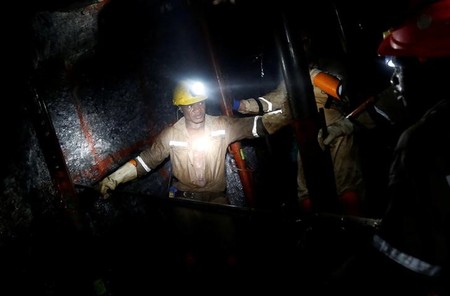JOHANNESBURG (Reuters) – South African-based gold and platinum producer Sibanye-Stillwater reported an attributable loss for 2017 and in a bid to preserve cash turned off the dividend flow that has made it a darling of investors
Sibanye’s share price fell 5 percent, underscoring disappointment among investors who have grown accustomed to hefty dividend payouts from the Gold Fields spin-off.
The company’s operations, including the troubled Rustenburg assets it acquired from Anglo American Platinum, delivered solid results, with the loss stemming from impairments, provisions for occupational healthcare claims, and restructuring and transaction costs among other factors.
Sibanye-Stillwater reported an attributable loss of 4.437 billion rand ($333 million) for the year ended 31 December 2017, compared with attributable earnings of 3.473 billion rand ($237 million) for the year ended 31 December 2016.
“In the near term, cash preservation is prudent and as a result no final dividend is being declared,” the company, which has given over 4 billion rand back to shareholders since 2013, said.
Sibanye initially positioned itself as a dividend play with cash flowing from mature South African gold assets that did not require huge investment, but it has been expanding into platinum and beyond South Africa, diverting its dividend flow.
Its dividend yield is now 2.882 percent, almost the same as the 2.84 percent for Johannesburg’s All-share index.
The healthcare provision has been put aside for an expected settlement in a class-action suit against six current and previous South African gold producers related to a fatal lung disease. This also hit AngloGold Ashanti’s earnings.
It was launched almost six years ago on behalf of miners suffering from silicosis, a fatal lung disease contacted by inhaling silica dust in gold mines, and is expected to be settled in a few months.
Overall, Sibanye’s operational performance was good, suggesting it will return to profits and dividends.
The company said its labour-intensive Rustenburg platinum operations west of Johannesburg – which under Amplats were loss-making and flashpoints of violent labour unrest – contributed 1.6 billion rand or 18 percent to group adjusted EBITDA.
“The Rustenburg operations have consistently delivered solid production and improved financial results, with approximately 1 billion rand in cost savings and synergies realised in the first year of incorporation, well ahead of initial expectations of 800 million rand over three to four years,” the company said.
“This is a remarkable result from assets which, before being part of the Sibanye-Stillwater Group, had been delivering significant and sustained losses for many years,” said chief executive Neal Froneman.
(Reporting by Ed Stoddard; Editing by Tiisetso Motsoeneng and Adrian Croft)




